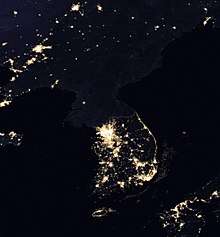Energy in North Korea
.jpg)
Energy in North Korea describes energy and electricity production, consumption and import in North Korea.
North Korea is a net energy exporter. Primary energy use in North Korea was 224 TWh and 9 TWh per million people in 2009.[1]
North Korea energy production in relation to population was about same as is in South Korea in 2004–2009. The difference is in the energy import. North Korea is almost self-sufficient in energy. The energy import is very small in North Korea and 86% of primary energy use in South Korea. North Korea's population in 2009 was 23,91 million, and 48,75 million in South Korea.
Overview

| Energy in North Korea[2] | ||||||
|---|---|---|---|---|---|---|
| Capita | Prim. energy | Production | Export | Electricity | CO2-emission | |
| Million | TWh | TWh | TWh | TWh | Mt | |
| 2004 | 22.38 | 237 | 223 | -15 | 18.50 | 70.20 |
| 2007 | 23.78 | 214 | 229 | 15 | 18.12 | 62.32 |
| 2008 | 23.86 | 236 | 242 | 6 | 19.54 | 69.37 |
| 2009 | 23.91 | 224 | 236 | 12 | 17.76 | 66.20 |
| 2012 | 24.45 | 18.21 | 64.82 | |||
| 2012R | 24.76 | 164 | 236 | 72 | 16.20 | 45.42 |
| 2013 | 24.90 | 168 | 280 | 112 | 16.44 | 47.68 |
| Change 2004-09 | 6.8 % | -5.4 % | 5.5 % | - | -4.0 % | -5.7 % |
| Mtoe = 11.63 TWh, Prim. energy includes energy losses that are 2/3 for nuclear power[3]
2012R = CO2 calculation criteria changed, numbers updated | ||||||
Per capita electricity consumption
According to statistics compiled by the South Korean agency, Statistics Korea, based on International Energy Agency (IEA) data, per capita electricity consumption fell from its peak in 1990 of 1247 kilowatt hours to a low of 712 kilowatt hours in 2000. It has slowly risen since to 819 kilowatt hours in 2008, a level below that of 1970.[4][5]
In 2017 many homes were using small standalone photovoltaic systems.[6][7]
Oil imports
North Korea imports crude oil from an aging pipeline that originates in Dandong, China. The crude oil is refined at the Ponghwa Chemical Factory in Sinuiju, North Korea.[8] North Korea has a smaller oil refinery, the Sŭngri Refinery, on its Russian border.
North Korea imports jet fuel, diesel fuel, and gasoline from two refineries in Dalian, China, which arrive at the North Korean port of Nampo.[8]
Power facilities
See also
References
- ↑ 2011 IEA Key energy statistics 2011 Archived 2011-10-27 at the Wayback Machine. Page: Country specific indicator numbers from page 48
- ↑ IEA Key World Energy Statistics Statistics 2015 Archived 2016-03-13 at WebCite, 2014 (2012R as in November 2015 Archived 2015-05-05 at WebCite + 2012 as in March 2014 is comparable to previous years statistical calculation criteria, 2013 Archived 2014-09-02 at the Wayback Machine., 2012 Archived 2013-03-09 at the Wayback Machine., 2011 Archived 2011-10-27 at the Wayback Machine., 2010 Archived 2010-10-11 at the Wayback Machine., 2009 Archived 2013-10-07 at the Wayback Machine., 2006 Archived 2009-10-12 at the Wayback Machine. IEA October, crude oil p. 11, coal p. 13 gas p. 15
- ↑ Energy in Sweden 2010 Archived October 16, 2013, at the Wayback Machine., Facts and figures, The Swedish Energy Agency, Table 8 Losses in nuclear power stations Table 9 Nuclear power brutto
- ↑ Kim Tae Hong (August 6, 2012). "Economic Collapse Reflected in Scarce Electricity". Daily NK. Archived from the original on September 4, 2012. Retrieved August 6, 2012.
- ↑ "N. Korea's power consumption per capita at 1970s levels". Yonhap News. Yonhap. August 6, 2012. Archived from the original on October 22, 2014. Retrieved August 6, 2012.
- ↑ Frank, Ruediger (6 April 2017). "Consumerism in North Korea: The Kwangbok Area Shopping Center". 38 North. U.S.-Korea Institute, Johns Hopkins University School of Advanced International Studies. Archived from the original on 11 April 2017. Retrieved 10 April 2017.
- ↑ Lankov, Andrei (31 May 2017). "How North Korea 's electricity supply became one of the world's worst". NK News. Retrieved 21 October 2017.
outside walls of houses are nearly all plastered with solar panels
- 1 2 Aizhu, Chen (2017-04-28). "How North Korea gets its oil from China: lifeline in question at U.N. meeting". Reuters. Retrieved 2017-09-09.
Further reading
- Ahn, Se Hyun (2013). "North Korea's Energy Conundrum: Is Natural Gas the Remedy?". Asian Survey. 53 (6): 1037–1062. doi:10.1525/as.2013.53.6.1037. ISSN 0004-4687.
External links
